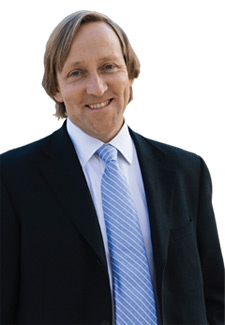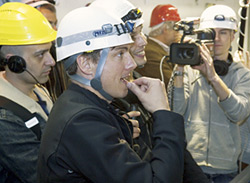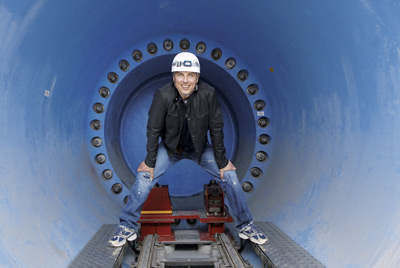Q&A: james gillies
Hollywood directors, time travelers, journalists, school kids—CERN’s press office sees them all. symmetry’s Glennda Chui talks to James Gillies, head of communication, about what it’s like to handle the increasing demand for tours and information as the lab prepares to switch on the Large Hadron Collider.
 |
| James Gillies, head of communications at CERN. Photo: CERN |
Q: I hear things are really heating up there.
A: In a typical year we get around 300 individual media visits. We had many more visits in 2004, which was our 50th anniversary year, and since then the numbers have just been rising, to well over 1000 individual visits from more than 500 media in 2007. We’ve been telling people that if you want to come and see and look around, this is the last chance to do it.
Q: Wasn’t 2004 also when Dan Brown’s novel, Angels and Demons, took off?
A: Yes, and it made a big difference. The book is about a secret society that steals antimatter from CERN to make a bomb to destroy the Vatican. Before that, we were running 20,000 or 30,000 visitors per month on our Web site; just about overnight it went up to a quarter of a million visitors a month and stayed there. So although the science in the book is pretty much nonsensical, in terms of raising awareness it’s done us a great favor.
Q: So you and the Catholic Church find yourselves in the same position of trying to correct the record on Dan Brown’s books.
A: When something like this comes up, you can stick your head in the sand and pretend it doesn’t exist. You can attack it. Or you can just run along with it and have fun with it, and that’s what we did. We put a fact-and-fiction page about Angels and Demons on our Web site. We actually asked Georges Charpak, a Nobel Prize-winning physicist who plays Frisbee in the book, if he ever plays Frisbee. He said no. But we point out that you can play Frisbee with other Nobel Prize winners and people do, out there on the lawn.
Q: Now Ron Howard, the American director, is making a film version.
A: He was here last summer and I was quite impressed, actually. He wants, as far as I can tell, to do right by us in this film, to make the science as plausible as it possibly can be, given the constraints he was working with. It was quite fun, discussing the storyline and how it might be made into a movie. They were looking at filming here next summer, but at some point in 2008 we’ll be running and then nobody will be going into the tunnel whilst that’s happening.
 |
| Actor John Barrowman, who plays the time-traveling Captain Jack in the Doctor Who TV series, films a podcast at CERN, above and below. Photos: CERN |
Q: Captain Jack also put in an appearance.
A: The actor who plays Captain Jack, John Barrowman, came in April to record the first of a series of podcasts set at CERN. He was hilarious. He plays this character in Doctor Who, a science fiction series that involves time travel. One of our particle detectors is called the time projection chamber, which is a very exotic name. But you cannot, of course, use it to travel back in time.
Q: CERN even played a role in Sunshine, which doesn’t even mention the lab.
A: The hero of the film is a physicist, actually, who leads a mission to reignite the dying sun. The guy who played the hero came and stayed with one of our physicists for two weeks; as a result, CERN got mentioned in the film pages of all sorts of newspapers. The basic message was, “The hero is a physicist and he’s a really cool character. And OK, it’s very improbable that we’ll have to face a catastrophe like this, but the truth of the matter is there’s an awful lot out there in the universe that we don’t understand, and the impression we have of the universe as a nice benign place to live is false, and so if we wish to carry on living peacefully in the universe, we’d better understand it better than we do now, and the way to do that is through particle physics.” So it got great coverage for us, in places you don’t normally expect particle physics to be.
 |
Q: As you get closer to the opening of the LHC, I can imagine a collision course in which the scientists who normally guide tours are too busy, but there’s more and more demand from people wanting to see things.
A: There will be, but there are also more and more scientists coming here as we get closer, so that will be sort of offset. The challenge is new itineraries. There’s a lot of energy in the LHC’s beams, and we can’t take people down there when it’s operating. We have to find new places that are every bit as exciting as going down into these caverns, and I think we can do it. For instance, we’re building an exhibition point at the ATLAS experiment, overlooking the control room, so people will be able to see science happening; I hope we’ll be doing the same for CMS.
Q: How will you handle the startup of the LHC?
A: We are committed now to an open-house weekend in 2008—Saturday, April 5th, for CERN people and Sunday, the 6th, for the public. Hopefully we will be opening all eight access points to the LHC, and inviting people in the community to visit the one closest to where they live. We’re still working on what we do with media, but we’ll probably invite them to come on the day we try to put beam into the LHC for the first time.
Q: Isn’t it a bit risky to invite the media on the actual day? Wouldn’t you normally announce the start of operations only after the fact, in case some last-minute glitch develops?
A: True, that’s the way it’s normally done. But I don’t think there’s ever been so much interest in the start of a particle accelerator, so I don’t think we really have much option. And actually it will work to our advantage. BBC Radio 4, the premium talk-radio station in the United Kingdom, is bringing its whole network here, and every program on that day will have a particle physics theme, and they need a date to publish in their schedules.
We’ll bill it as a curtain raiser, a precursor to news to come, but we will have to be careful to manage media expectations on and around the day. So we say this is the day that we try to put beam into the LHC, and we explain very carefully that this is not the day when we first get collisions. I think people could understand that. People understand that when you launch a rocket, you’re not getting results straightaway.
Click here to download the pdf version of this article.






